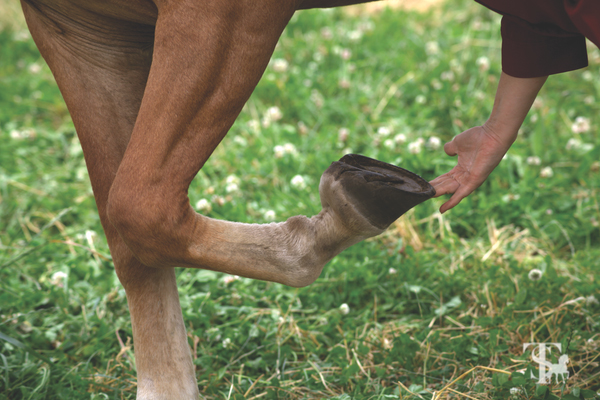This excerpt from Where Does My Horse Hurt? by Dr. Renee Tucker was reprinted with permission from Trafalgar Square Books (www.horseandriderbooks.com).
In this simple “body checkup” from the book Where Does My Horse Hurt?, veterinarian and certified chiropractor Dr. Renee Tucker explains how to find out if your jumping horse has pain in his fetlocks. Even better: You can perform this checkup on your own horse.
I did a quick Body Checkup on a five-year-old Thoroughbred hunter mare that was on a two-week trial period prior to purchase. I found some lumbar subluxations, but what concerned me more was the amount of back-muscle tightness I noted in her: It was much more than I would have expected from the subluxations.
As I finished checking the mare’s legs, I was quite surprised to find both her front fetlocks had at least 50 percent less range of motion than normal. They should have easily bent up toward her knees when I picked up her front feet. They didn’t! They only bent about halfway before they felt “frozen” in place. I believe that her back muscles had become so tight due to her need to compensate for her fetlock problem.
The potential owner was happy I discovered this problem, saving her close to $1,000 in veterinary pre-purchase exams and X-rays. There was no way this mare could have held up to a rigorous jumping schedule without normal fetlock flexion. The mare went on to find a happy home where there was no jumping involved.
BEHAVIOR OR PERFORMANCE SYMPTOMS OF FETLOCK PROBLEMS
Very Common
- Decreased flexion of fetlock
- Tripping in front
- Feet landing toe first
- Reluctance to jump
- Stumbling on tight turns or around barrels
Frequent
- Stiff in the front end
- Difficulty with turns
Occasional
- Struggles with front end lateral work
- Short-striding, or “off” in front
PHYSICAL SYMPTOMS: CURRENT OR PRIOR
- History of ligament strain
- Tendency to grow to excess heel
FUNCTION: The fetlock facilitates force coming from the ground and traveling up the leg properly (acts as a shock absorber) and also helps with flexion in the front leg.
RANGE OF MOTION: The fetlock’s normal range is quite large. When the horse is standing with his legs perpendicular to the ground, the fetlock is forward approximately 45 degrees. When flexed, the fetlock angle should move approximately 75 degrees to the back.
How to Do the Checkup
First, pick up one of the horse’s legs, and be sure the entire leg is relaxed. Sometimes a horse, expecting you to clean out his foot, tries to be “helpful” by holding his leg up for you, so wait a minute or so until he relaxes his whole leg and lets you hold it up. Then check the fetlock range of motion by holding the toe of the hoof and watching how far it automatically flexes, followed by adding pressure until it stops flexing while supporting the horse’s leg with your free hand.
Diagnosis
When the fetlock does not flex comfortably through the entire range of motion, it may need chiropractic adjustment. Or, it may have a decreased range of motion because of arthritis, tendon stiffness or adhesions, or sesamoid bone subluxations.
Compare both front fetlocks. If they have the same amount of flexion, you typically do not have a chiropractic issue. Check the fetlocks in the hind legs, as well.
When subluxation diagnosed (uncommon), call a chiropractor.
When the checkup is fine, but the horse’s symptoms remain, check for:
- Subluxation of the sesamoid bones
- Fetlock arthritis
- Hoof-wall imbalance
- Mineral or vitamin imbalance
- Early flexor tendon strain
- Heel-pain syndrome
- “Joint mice” in fetlock
Pick up your copy of Where Does My Horse Hurt? from Trafalgar Square Books HERE!


